OMGT 1070 - Inventory Management: Comparative Case Study Analysis
VerifiedAdded on 2023/06/12
|14
|3510
|482
Report
AI Summary
This report provides a comparative analysis of inventory management strategies across three research articles and corresponding case studies. The analysis focuses on addressing inventory challenges in small enterprises, particularly in managing perishable goods and optimizing inventory positioning. The report critically evaluates inventory management policies, including forecasting techniques, supplier selection, and the implementation of technologies like RFID. Solutions are proposed for each case study, emphasizing the importance of historical data analysis, supplier relationship management, and effective communication within the supply chain. The ultimate goal is to improve inventory control, reduce waste, and enhance overall business performance. The document is available on Desklib, a platform offering a wide range of study tools and resources for students.
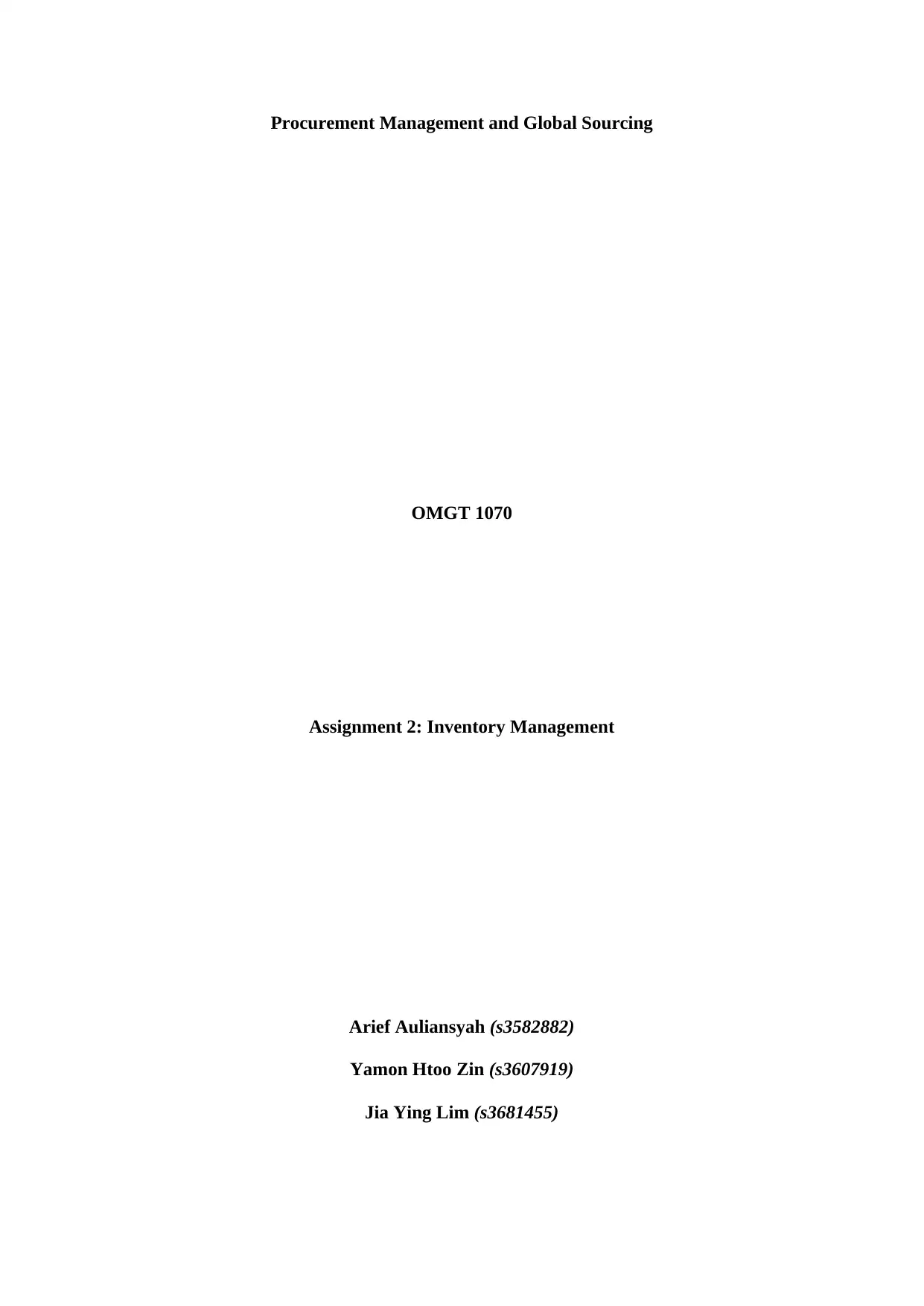
Procurement Management and Global Sourcing
OMGT 1070
Assignment 2: Inventory Management
Arief Auliansyah (s3582882)
Yamon Htoo Zin (s3607919)
Jia Ying Lim (s3681455)
OMGT 1070
Assignment 2: Inventory Management
Arief Auliansyah (s3582882)
Yamon Htoo Zin (s3607919)
Jia Ying Lim (s3681455)
Paraphrase This Document
Need a fresh take? Get an instant paraphrase of this document with our AI Paraphraser
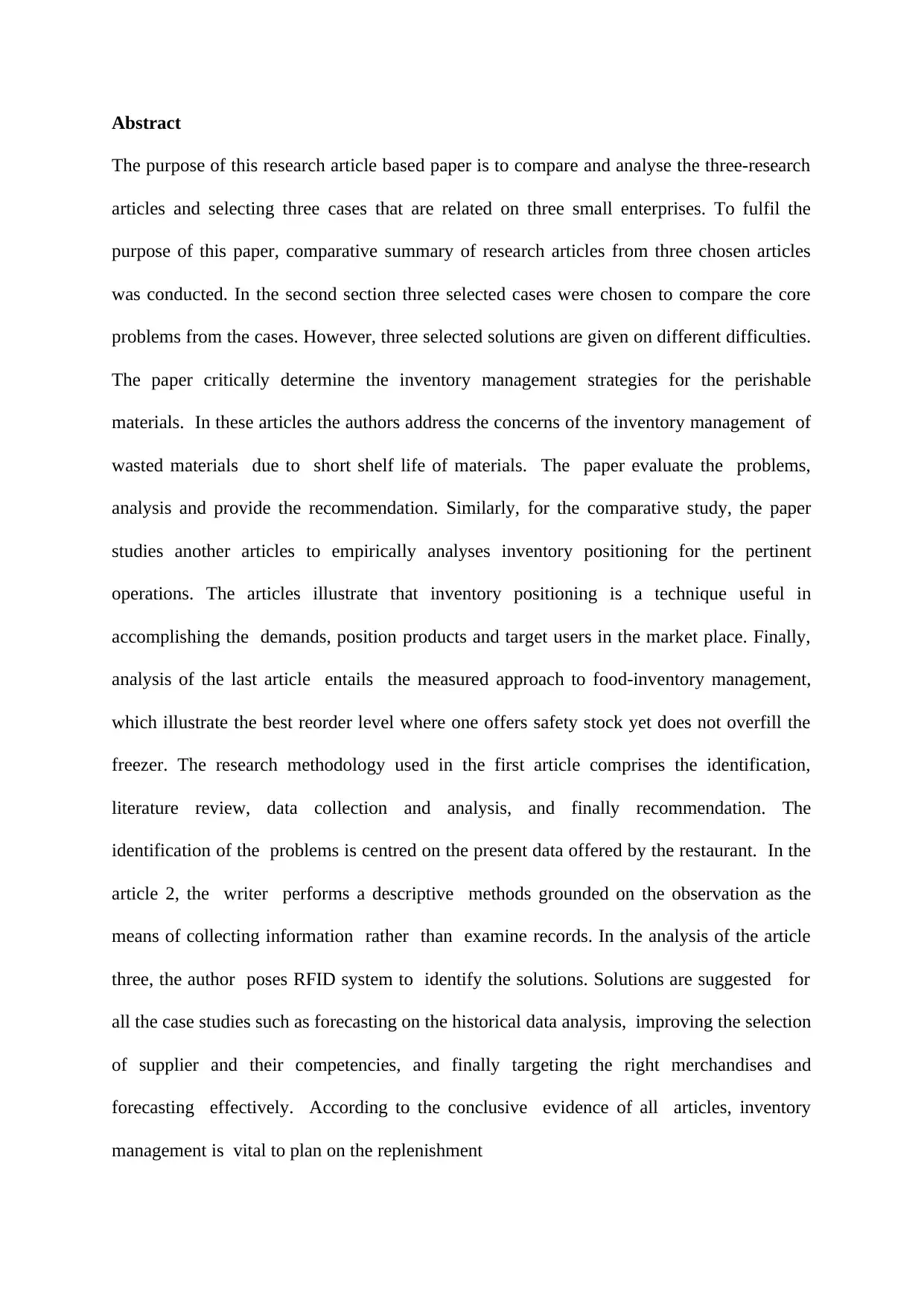
Abstract
The purpose of this research article based paper is to compare and analyse the three-research
articles and selecting three cases that are related on three small enterprises. To fulfil the
purpose of this paper, comparative summary of research articles from three chosen articles
was conducted. In the second section three selected cases were chosen to compare the core
problems from the cases. However, three selected solutions are given on different difficulties.
The paper critically determine the inventory management strategies for the perishable
materials. In these articles the authors address the concerns of the inventory management of
wasted materials due to short shelf life of materials. The paper evaluate the problems,
analysis and provide the recommendation. Similarly, for the comparative study, the paper
studies another articles to empirically analyses inventory positioning for the pertinent
operations. The articles illustrate that inventory positioning is a technique useful in
accomplishing the demands, position products and target users in the market place. Finally,
analysis of the last article entails the measured approach to food-inventory management,
which illustrate the best reorder level where one offers safety stock yet does not overfill the
freezer. The research methodology used in the first article comprises the identification,
literature review, data collection and analysis, and finally recommendation. The
identification of the problems is centred on the present data offered by the restaurant. In the
article 2, the writer performs a descriptive methods grounded on the observation as the
means of collecting information rather than examine records. In the analysis of the article
three, the author poses RFID system to identify the solutions. Solutions are suggested for
all the case studies such as forecasting on the historical data analysis, improving the selection
of supplier and their competencies, and finally targeting the right merchandises and
forecasting effectively. According to the conclusive evidence of all articles, inventory
management is vital to plan on the replenishment
The purpose of this research article based paper is to compare and analyse the three-research
articles and selecting three cases that are related on three small enterprises. To fulfil the
purpose of this paper, comparative summary of research articles from three chosen articles
was conducted. In the second section three selected cases were chosen to compare the core
problems from the cases. However, three selected solutions are given on different difficulties.
The paper critically determine the inventory management strategies for the perishable
materials. In these articles the authors address the concerns of the inventory management of
wasted materials due to short shelf life of materials. The paper evaluate the problems,
analysis and provide the recommendation. Similarly, for the comparative study, the paper
studies another articles to empirically analyses inventory positioning for the pertinent
operations. The articles illustrate that inventory positioning is a technique useful in
accomplishing the demands, position products and target users in the market place. Finally,
analysis of the last article entails the measured approach to food-inventory management,
which illustrate the best reorder level where one offers safety stock yet does not overfill the
freezer. The research methodology used in the first article comprises the identification,
literature review, data collection and analysis, and finally recommendation. The
identification of the problems is centred on the present data offered by the restaurant. In the
article 2, the writer performs a descriptive methods grounded on the observation as the
means of collecting information rather than examine records. In the analysis of the article
three, the author poses RFID system to identify the solutions. Solutions are suggested for
all the case studies such as forecasting on the historical data analysis, improving the selection
of supplier and their competencies, and finally targeting the right merchandises and
forecasting effectively. According to the conclusive evidence of all articles, inventory
management is vital to plan on the replenishment
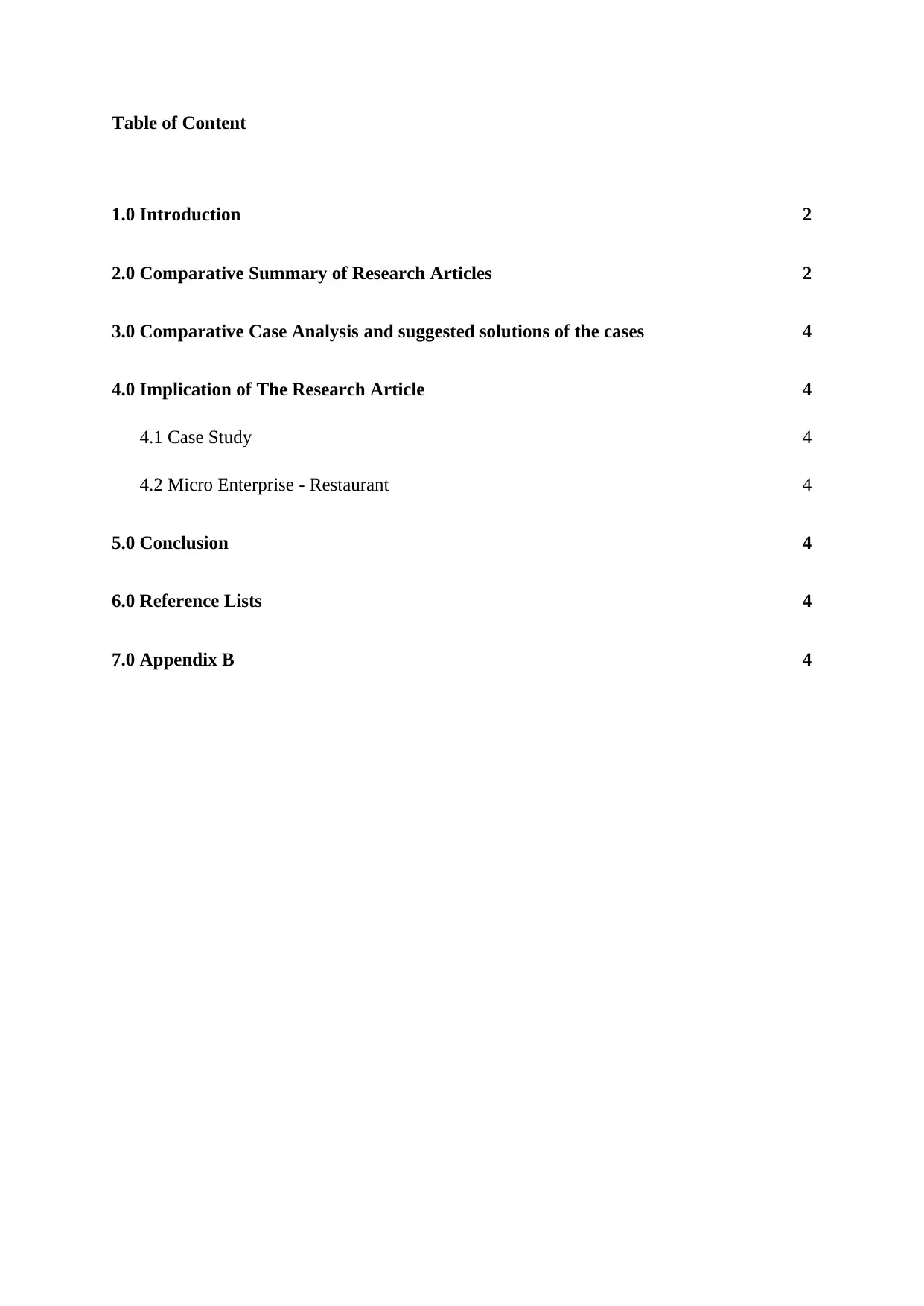
Table of Content
1.0 Introduction 2
2.0 Comparative Summary of Research Articles 2
3.0 Comparative Case Analysis and suggested solutions of the cases 4
4.0 Implication of The Research Article 4
4.1 Case Study 4
4.2 Micro Enterprise - Restaurant 4
5.0 Conclusion 4
6.0 Reference Lists 4
7.0 Appendix B 4
1.0 Introduction 2
2.0 Comparative Summary of Research Articles 2
3.0 Comparative Case Analysis and suggested solutions of the cases 4
4.0 Implication of The Research Article 4
4.1 Case Study 4
4.2 Micro Enterprise - Restaurant 4
5.0 Conclusion 4
6.0 Reference Lists 4
7.0 Appendix B 4
⊘ This is a preview!⊘
Do you want full access?
Subscribe today to unlock all pages.

Trusted by 1+ million students worldwide
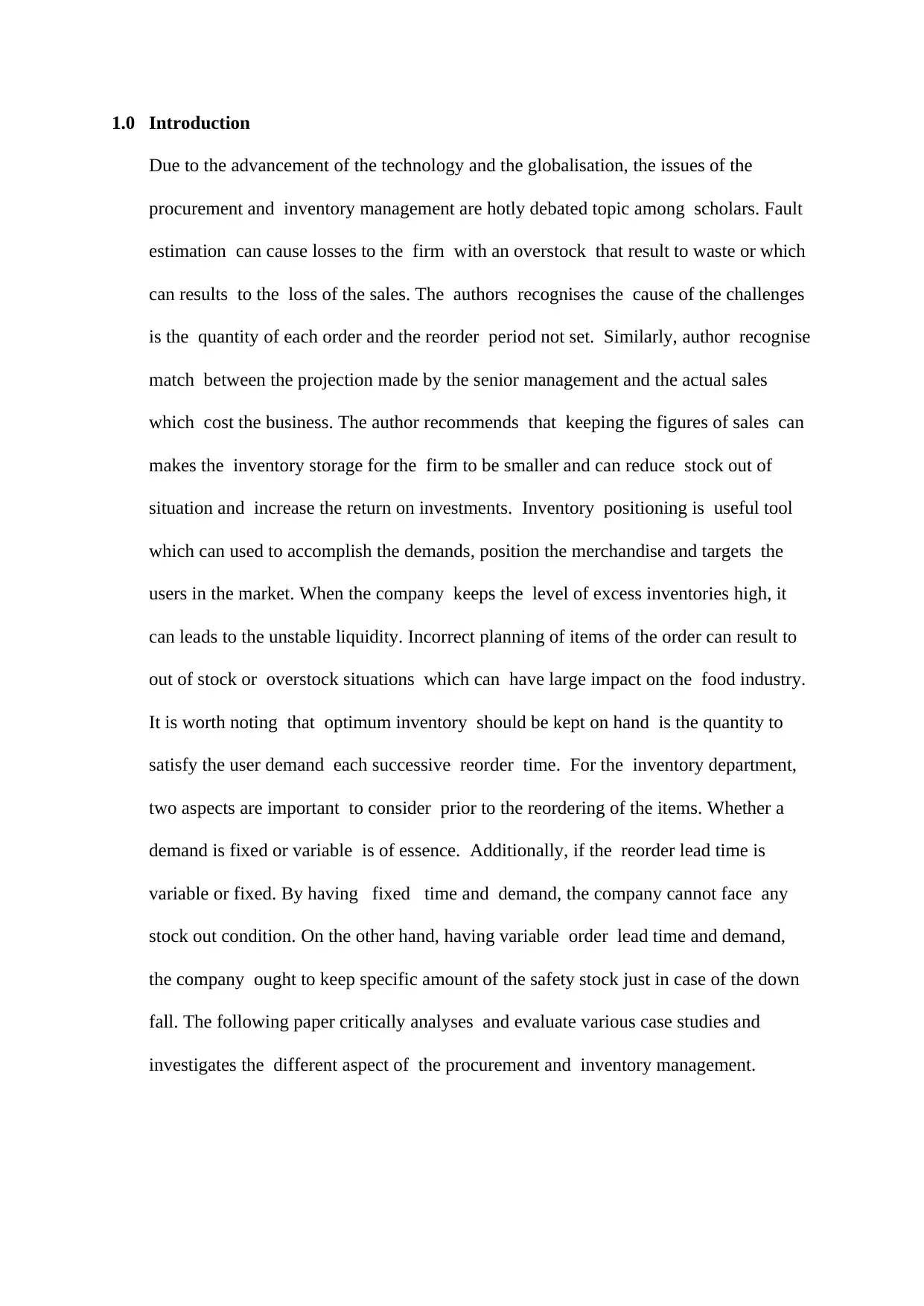
1.0 Introduction
Due to the advancement of the technology and the globalisation, the issues of the
procurement and inventory management are hotly debated topic among scholars. Fault
estimation can cause losses to the firm with an overstock that result to waste or which
can results to the loss of the sales. The authors recognises the cause of the challenges
is the quantity of each order and the reorder period not set. Similarly, author recognise
match between the projection made by the senior management and the actual sales
which cost the business. The author recommends that keeping the figures of sales can
makes the inventory storage for the firm to be smaller and can reduce stock out of
situation and increase the return on investments. Inventory positioning is useful tool
which can used to accomplish the demands, position the merchandise and targets the
users in the market. When the company keeps the level of excess inventories high, it
can leads to the unstable liquidity. Incorrect planning of items of the order can result to
out of stock or overstock situations which can have large impact on the food industry.
It is worth noting that optimum inventory should be kept on hand is the quantity to
satisfy the user demand each successive reorder time. For the inventory department,
two aspects are important to consider prior to the reordering of the items. Whether a
demand is fixed or variable is of essence. Additionally, if the reorder lead time is
variable or fixed. By having fixed time and demand, the company cannot face any
stock out condition. On the other hand, having variable order lead time and demand,
the company ought to keep specific amount of the safety stock just in case of the down
fall. The following paper critically analyses and evaluate various case studies and
investigates the different aspect of the procurement and inventory management.
Due to the advancement of the technology and the globalisation, the issues of the
procurement and inventory management are hotly debated topic among scholars. Fault
estimation can cause losses to the firm with an overstock that result to waste or which
can results to the loss of the sales. The authors recognises the cause of the challenges
is the quantity of each order and the reorder period not set. Similarly, author recognise
match between the projection made by the senior management and the actual sales
which cost the business. The author recommends that keeping the figures of sales can
makes the inventory storage for the firm to be smaller and can reduce stock out of
situation and increase the return on investments. Inventory positioning is useful tool
which can used to accomplish the demands, position the merchandise and targets the
users in the market. When the company keeps the level of excess inventories high, it
can leads to the unstable liquidity. Incorrect planning of items of the order can result to
out of stock or overstock situations which can have large impact on the food industry.
It is worth noting that optimum inventory should be kept on hand is the quantity to
satisfy the user demand each successive reorder time. For the inventory department,
two aspects are important to consider prior to the reordering of the items. Whether a
demand is fixed or variable is of essence. Additionally, if the reorder lead time is
variable or fixed. By having fixed time and demand, the company cannot face any
stock out condition. On the other hand, having variable order lead time and demand,
the company ought to keep specific amount of the safety stock just in case of the down
fall. The following paper critically analyses and evaluate various case studies and
investigates the different aspect of the procurement and inventory management.
Paraphrase This Document
Need a fresh take? Get an instant paraphrase of this document with our AI Paraphraser
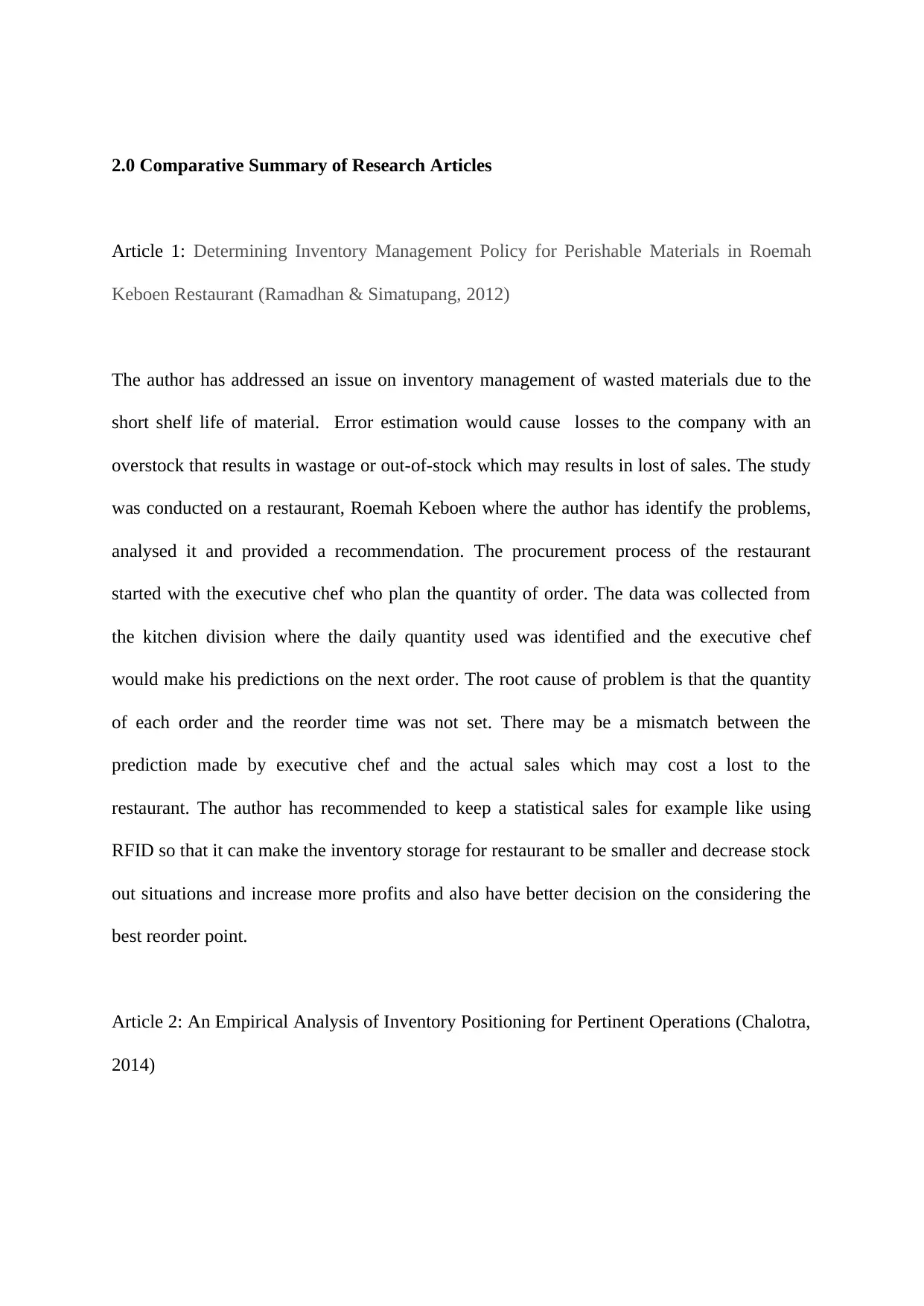
2.0 Comparative Summary of Research Articles
Article 1: Determining Inventory Management Policy for Perishable Materials in Roemah
Keboen Restaurant (Ramadhan & Simatupang, 2012)
The author has addressed an issue on inventory management of wasted materials due to the
short shelf life of material. Error estimation would cause losses to the company with an
overstock that results in wastage or out-of-stock which may results in lost of sales. The study
was conducted on a restaurant, Roemah Keboen where the author has identify the problems,
analysed it and provided a recommendation. The procurement process of the restaurant
started with the executive chef who plan the quantity of order. The data was collected from
the kitchen division where the daily quantity used was identified and the executive chef
would make his predictions on the next order. The root cause of problem is that the quantity
of each order and the reorder time was not set. There may be a mismatch between the
prediction made by executive chef and the actual sales which may cost a lost to the
restaurant. The author has recommended to keep a statistical sales for example like using
RFID so that it can make the inventory storage for restaurant to be smaller and decrease stock
out situations and increase more profits and also have better decision on the considering the
best reorder point.
Article 2: An Empirical Analysis of Inventory Positioning for Pertinent Operations (Chalotra,
2014)
Article 1: Determining Inventory Management Policy for Perishable Materials in Roemah
Keboen Restaurant (Ramadhan & Simatupang, 2012)
The author has addressed an issue on inventory management of wasted materials due to the
short shelf life of material. Error estimation would cause losses to the company with an
overstock that results in wastage or out-of-stock which may results in lost of sales. The study
was conducted on a restaurant, Roemah Keboen where the author has identify the problems,
analysed it and provided a recommendation. The procurement process of the restaurant
started with the executive chef who plan the quantity of order. The data was collected from
the kitchen division where the daily quantity used was identified and the executive chef
would make his predictions on the next order. The root cause of problem is that the quantity
of each order and the reorder time was not set. There may be a mismatch between the
prediction made by executive chef and the actual sales which may cost a lost to the
restaurant. The author has recommended to keep a statistical sales for example like using
RFID so that it can make the inventory storage for restaurant to be smaller and decrease stock
out situations and increase more profits and also have better decision on the considering the
best reorder point.
Article 2: An Empirical Analysis of Inventory Positioning for Pertinent Operations (Chalotra,
2014)
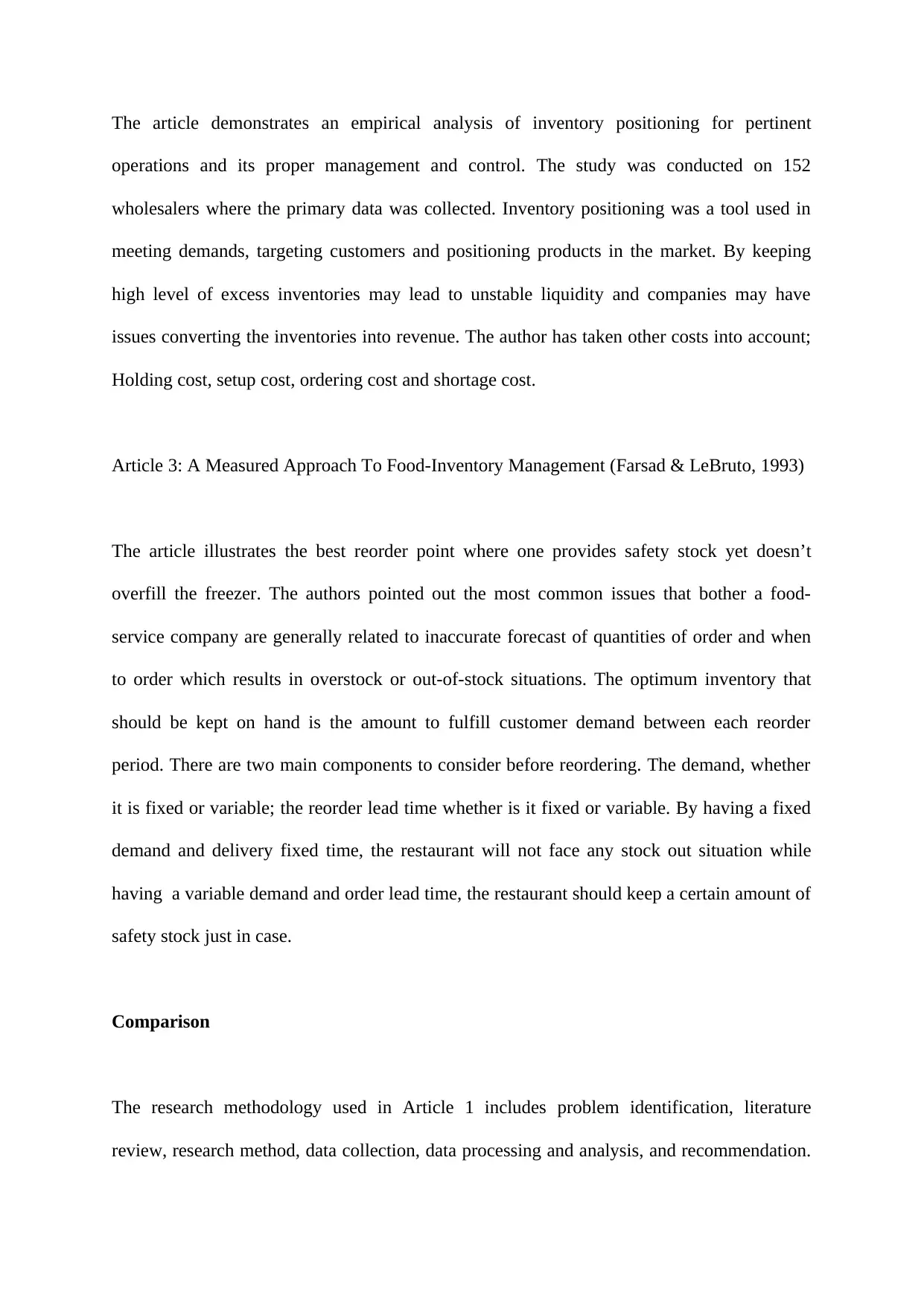
The article demonstrates an empirical analysis of inventory positioning for pertinent
operations and its proper management and control. The study was conducted on 152
wholesalers where the primary data was collected. Inventory positioning was a tool used in
meeting demands, targeting customers and positioning products in the market. By keeping
high level of excess inventories may lead to unstable liquidity and companies may have
issues converting the inventories into revenue. The author has taken other costs into account;
Holding cost, setup cost, ordering cost and shortage cost.
Article 3: A Measured Approach To Food-Inventory Management (Farsad & LeBruto, 1993)
The article illustrates the best reorder point where one provides safety stock yet doesn’t
overfill the freezer. The authors pointed out the most common issues that bother a food-
service company are generally related to inaccurate forecast of quantities of order and when
to order which results in overstock or out-of-stock situations. The optimum inventory that
should be kept on hand is the amount to fulfill customer demand between each reorder
period. There are two main components to consider before reordering. The demand, whether
it is fixed or variable; the reorder lead time whether is it fixed or variable. By having a fixed
demand and delivery fixed time, the restaurant will not face any stock out situation while
having a variable demand and order lead time, the restaurant should keep a certain amount of
safety stock just in case.
Comparison
The research methodology used in Article 1 includes problem identification, literature
review, research method, data collection, data processing and analysis, and recommendation.
operations and its proper management and control. The study was conducted on 152
wholesalers where the primary data was collected. Inventory positioning was a tool used in
meeting demands, targeting customers and positioning products in the market. By keeping
high level of excess inventories may lead to unstable liquidity and companies may have
issues converting the inventories into revenue. The author has taken other costs into account;
Holding cost, setup cost, ordering cost and shortage cost.
Article 3: A Measured Approach To Food-Inventory Management (Farsad & LeBruto, 1993)
The article illustrates the best reorder point where one provides safety stock yet doesn’t
overfill the freezer. The authors pointed out the most common issues that bother a food-
service company are generally related to inaccurate forecast of quantities of order and when
to order which results in overstock or out-of-stock situations. The optimum inventory that
should be kept on hand is the amount to fulfill customer demand between each reorder
period. There are two main components to consider before reordering. The demand, whether
it is fixed or variable; the reorder lead time whether is it fixed or variable. By having a fixed
demand and delivery fixed time, the restaurant will not face any stock out situation while
having a variable demand and order lead time, the restaurant should keep a certain amount of
safety stock just in case.
Comparison
The research methodology used in Article 1 includes problem identification, literature
review, research method, data collection, data processing and analysis, and recommendation.
⊘ This is a preview!⊘
Do you want full access?
Subscribe today to unlock all pages.

Trusted by 1+ million students worldwide
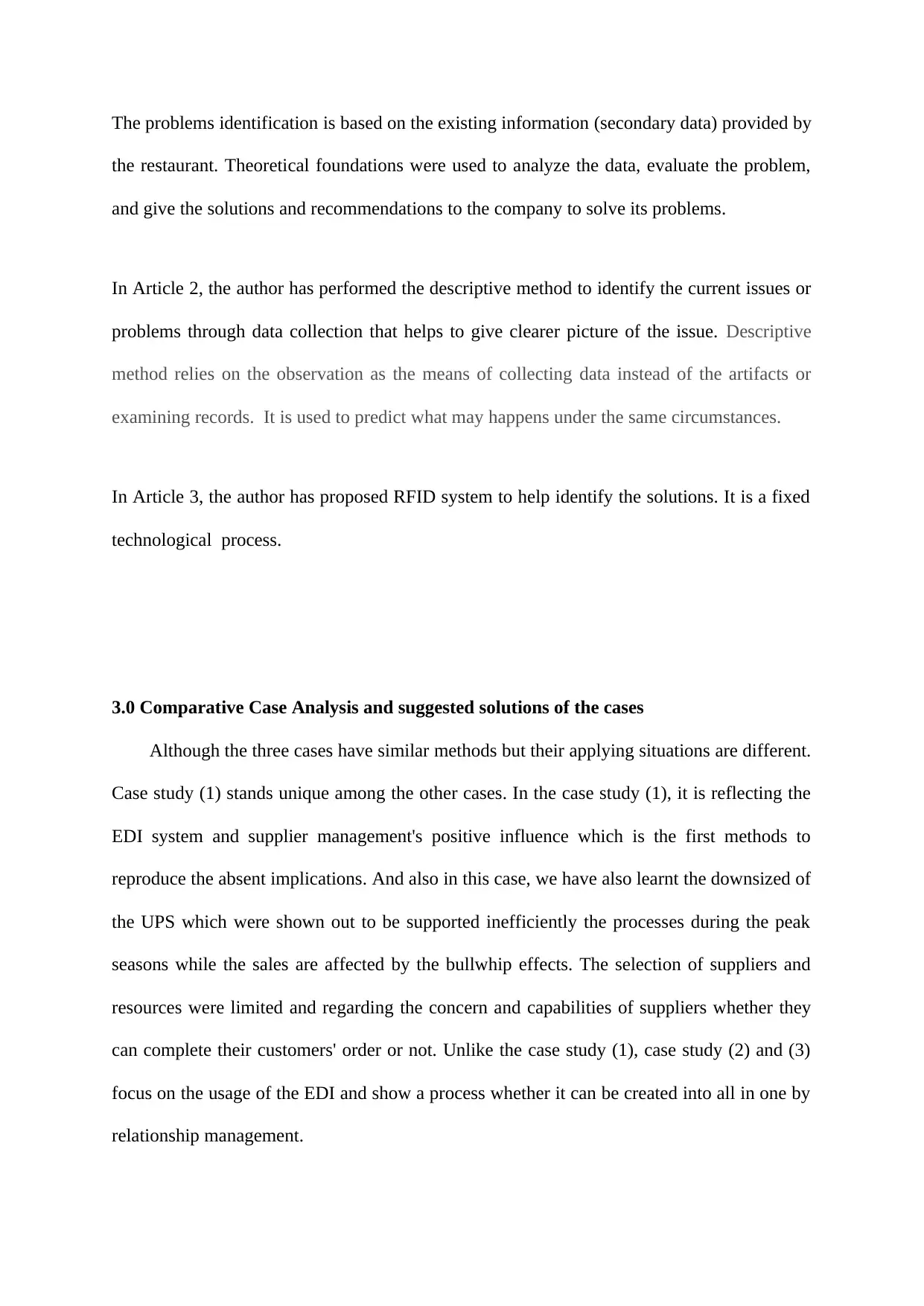
The problems identification is based on the existing information (secondary data) provided by
the restaurant. Theoretical foundations were used to analyze the data, evaluate the problem,
and give the solutions and recommendations to the company to solve its problems.
In Article 2, the author has performed the descriptive method to identify the current issues or
problems through data collection that helps to give clearer picture of the issue. Descriptive
method relies on the observation as the means of collecting data instead of the artifacts or
examining records. It is used to predict what may happens under the same circumstances.
In Article 3, the author has proposed RFID system to help identify the solutions. It is a fixed
technological process.
3.0 Comparative Case Analysis and suggested solutions of the cases
Although the three cases have similar methods but their applying situations are different.
Case study (1) stands unique among the other cases. In the case study (1), it is reflecting the
EDI system and supplier management's positive influence which is the first methods to
reproduce the absent implications. And also in this case, we have also learnt the downsized of
the UPS which were shown out to be supported inefficiently the processes during the peak
seasons while the sales are affected by the bullwhip effects. The selection of suppliers and
resources were limited and regarding the concern and capabilities of suppliers whether they
can complete their customers' order or not. Unlike the case study (1), case study (2) and (3)
focus on the usage of the EDI and show a process whether it can be created into all in one by
relationship management.
the restaurant. Theoretical foundations were used to analyze the data, evaluate the problem,
and give the solutions and recommendations to the company to solve its problems.
In Article 2, the author has performed the descriptive method to identify the current issues or
problems through data collection that helps to give clearer picture of the issue. Descriptive
method relies on the observation as the means of collecting data instead of the artifacts or
examining records. It is used to predict what may happens under the same circumstances.
In Article 3, the author has proposed RFID system to help identify the solutions. It is a fixed
technological process.
3.0 Comparative Case Analysis and suggested solutions of the cases
Although the three cases have similar methods but their applying situations are different.
Case study (1) stands unique among the other cases. In the case study (1), it is reflecting the
EDI system and supplier management's positive influence which is the first methods to
reproduce the absent implications. And also in this case, we have also learnt the downsized of
the UPS which were shown out to be supported inefficiently the processes during the peak
seasons while the sales are affected by the bullwhip effects. The selection of suppliers and
resources were limited and regarding the concern and capabilities of suppliers whether they
can complete their customers' order or not. Unlike the case study (1), case study (2) and (3)
focus on the usage of the EDI and show a process whether it can be created into all in one by
relationship management.
Paraphrase This Document
Need a fresh take? Get an instant paraphrase of this document with our AI Paraphraser
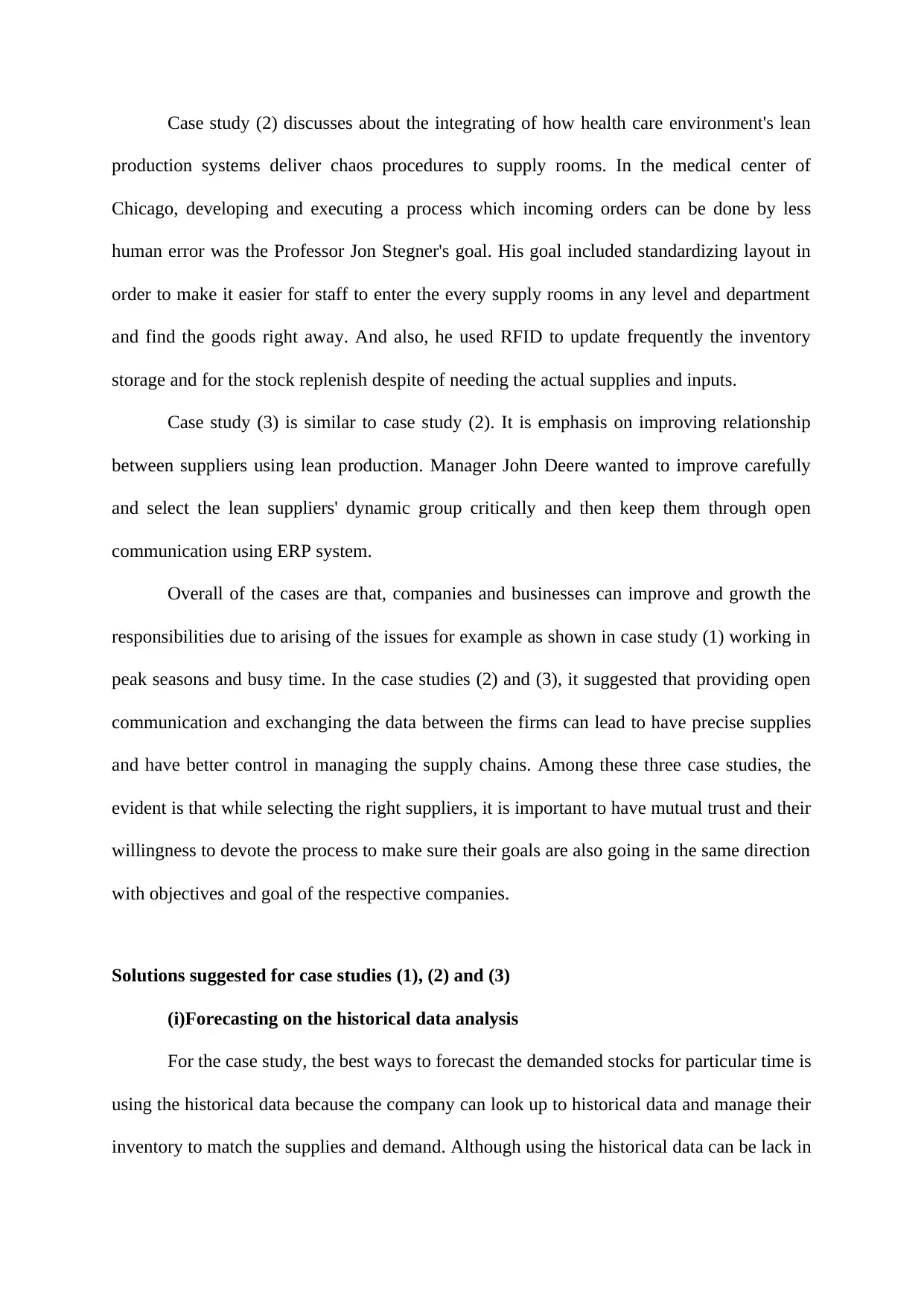
Case study (2) discusses about the integrating of how health care environment's lean
production systems deliver chaos procedures to supply rooms. In the medical center of
Chicago, developing and executing a process which incoming orders can be done by less
human error was the Professor Jon Stegner's goal. His goal included standardizing layout in
order to make it easier for staff to enter the every supply rooms in any level and department
and find the goods right away. And also, he used RFID to update frequently the inventory
storage and for the stock replenish despite of needing the actual supplies and inputs.
Case study (3) is similar to case study (2). It is emphasis on improving relationship
between suppliers using lean production. Manager John Deere wanted to improve carefully
and select the lean suppliers' dynamic group critically and then keep them through open
communication using ERP system.
Overall of the cases are that, companies and businesses can improve and growth the
responsibilities due to arising of the issues for example as shown in case study (1) working in
peak seasons and busy time. In the case studies (2) and (3), it suggested that providing open
communication and exchanging the data between the firms can lead to have precise supplies
and have better control in managing the supply chains. Among these three case studies, the
evident is that while selecting the right suppliers, it is important to have mutual trust and their
willingness to devote the process to make sure their goals are also going in the same direction
with objectives and goal of the respective companies.
Solutions suggested for case studies (1), (2) and (3)
(i)Forecasting on the historical data analysis
For the case study, the best ways to forecast the demanded stocks for particular time is
using the historical data because the company can look up to historical data and manage their
inventory to match the supplies and demand. Although using the historical data can be lack in
production systems deliver chaos procedures to supply rooms. In the medical center of
Chicago, developing and executing a process which incoming orders can be done by less
human error was the Professor Jon Stegner's goal. His goal included standardizing layout in
order to make it easier for staff to enter the every supply rooms in any level and department
and find the goods right away. And also, he used RFID to update frequently the inventory
storage and for the stock replenish despite of needing the actual supplies and inputs.
Case study (3) is similar to case study (2). It is emphasis on improving relationship
between suppliers using lean production. Manager John Deere wanted to improve carefully
and select the lean suppliers' dynamic group critically and then keep them through open
communication using ERP system.
Overall of the cases are that, companies and businesses can improve and growth the
responsibilities due to arising of the issues for example as shown in case study (1) working in
peak seasons and busy time. In the case studies (2) and (3), it suggested that providing open
communication and exchanging the data between the firms can lead to have precise supplies
and have better control in managing the supply chains. Among these three case studies, the
evident is that while selecting the right suppliers, it is important to have mutual trust and their
willingness to devote the process to make sure their goals are also going in the same direction
with objectives and goal of the respective companies.
Solutions suggested for case studies (1), (2) and (3)
(i)Forecasting on the historical data analysis
For the case study, the best ways to forecast the demanded stocks for particular time is
using the historical data because the company can look up to historical data and manage their
inventory to match the supplies and demand. Although using the historical data can be lack in
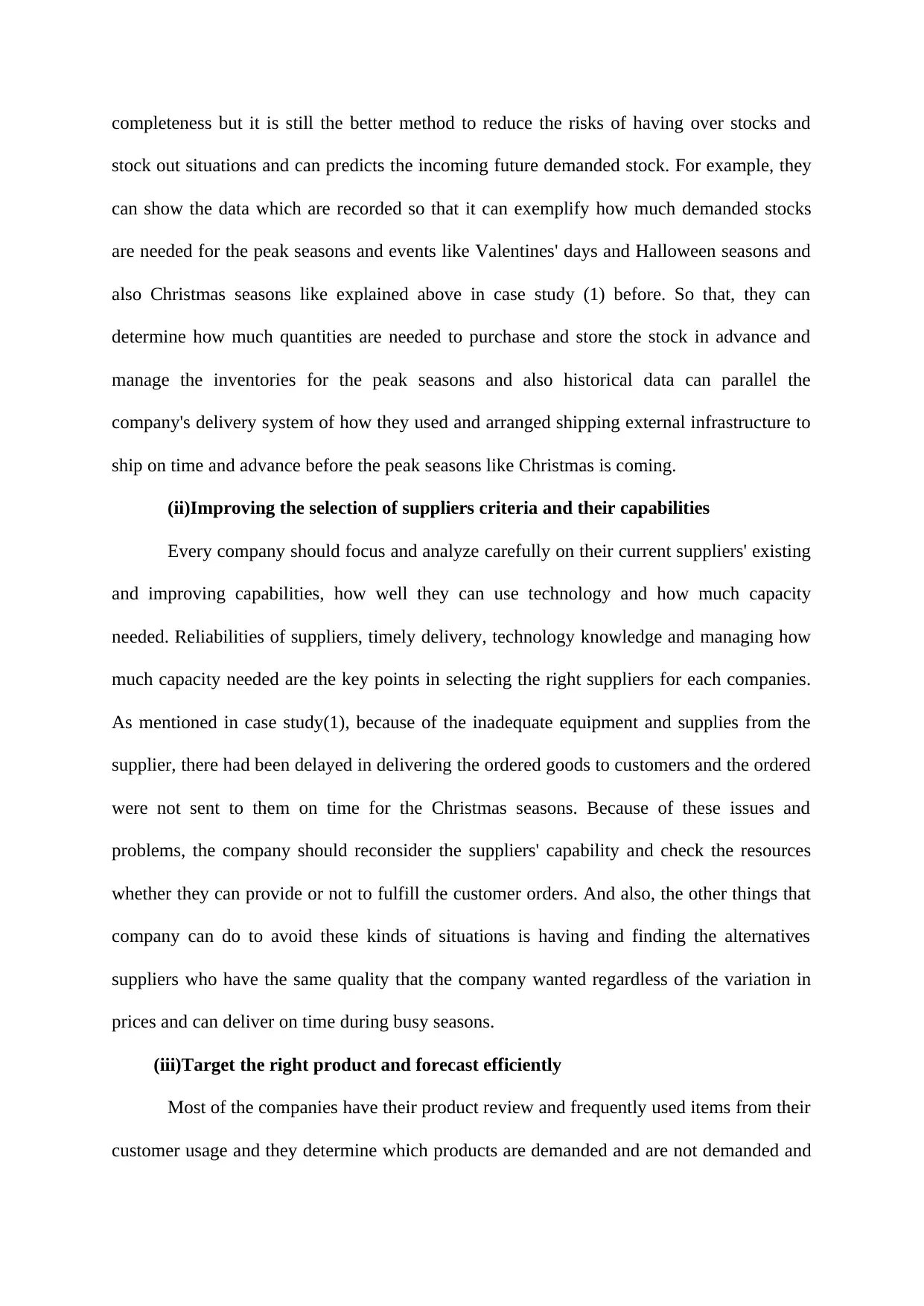
completeness but it is still the better method to reduce the risks of having over stocks and
stock out situations and can predicts the incoming future demanded stock. For example, they
can show the data which are recorded so that it can exemplify how much demanded stocks
are needed for the peak seasons and events like Valentines' days and Halloween seasons and
also Christmas seasons like explained above in case study (1) before. So that, they can
determine how much quantities are needed to purchase and store the stock in advance and
manage the inventories for the peak seasons and also historical data can parallel the
company's delivery system of how they used and arranged shipping external infrastructure to
ship on time and advance before the peak seasons like Christmas is coming.
(ii)Improving the selection of suppliers criteria and their capabilities
Every company should focus and analyze carefully on their current suppliers' existing
and improving capabilities, how well they can use technology and how much capacity
needed. Reliabilities of suppliers, timely delivery, technology knowledge and managing how
much capacity needed are the key points in selecting the right suppliers for each companies.
As mentioned in case study(1), because of the inadequate equipment and supplies from the
supplier, there had been delayed in delivering the ordered goods to customers and the ordered
were not sent to them on time for the Christmas seasons. Because of these issues and
problems, the company should reconsider the suppliers' capability and check the resources
whether they can provide or not to fulfill the customer orders. And also, the other things that
company can do to avoid these kinds of situations is having and finding the alternatives
suppliers who have the same quality that the company wanted regardless of the variation in
prices and can deliver on time during busy seasons.
(iii)Target the right product and forecast efficiently
Most of the companies have their product review and frequently used items from their
customer usage and they determine which products are demanded and are not demanded and
stock out situations and can predicts the incoming future demanded stock. For example, they
can show the data which are recorded so that it can exemplify how much demanded stocks
are needed for the peak seasons and events like Valentines' days and Halloween seasons and
also Christmas seasons like explained above in case study (1) before. So that, they can
determine how much quantities are needed to purchase and store the stock in advance and
manage the inventories for the peak seasons and also historical data can parallel the
company's delivery system of how they used and arranged shipping external infrastructure to
ship on time and advance before the peak seasons like Christmas is coming.
(ii)Improving the selection of suppliers criteria and their capabilities
Every company should focus and analyze carefully on their current suppliers' existing
and improving capabilities, how well they can use technology and how much capacity
needed. Reliabilities of suppliers, timely delivery, technology knowledge and managing how
much capacity needed are the key points in selecting the right suppliers for each companies.
As mentioned in case study(1), because of the inadequate equipment and supplies from the
supplier, there had been delayed in delivering the ordered goods to customers and the ordered
were not sent to them on time for the Christmas seasons. Because of these issues and
problems, the company should reconsider the suppliers' capability and check the resources
whether they can provide or not to fulfill the customer orders. And also, the other things that
company can do to avoid these kinds of situations is having and finding the alternatives
suppliers who have the same quality that the company wanted regardless of the variation in
prices and can deliver on time during busy seasons.
(iii)Target the right product and forecast efficiently
Most of the companies have their product review and frequently used items from their
customer usage and they determine which products are demanded and are not demanded and
⊘ This is a preview!⊘
Do you want full access?
Subscribe today to unlock all pages.

Trusted by 1+ million students worldwide
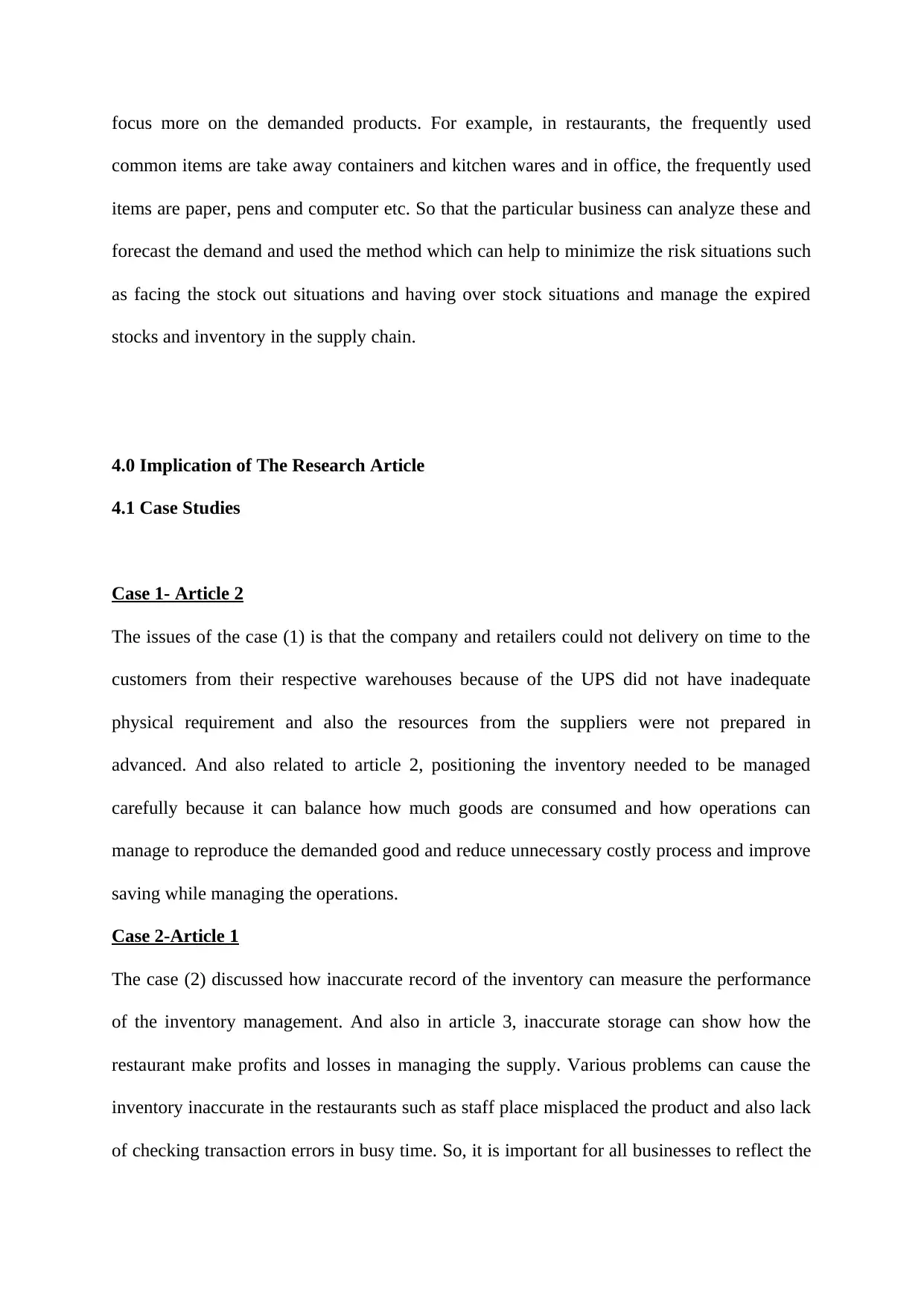
focus more on the demanded products. For example, in restaurants, the frequently used
common items are take away containers and kitchen wares and in office, the frequently used
items are paper, pens and computer etc. So that the particular business can analyze these and
forecast the demand and used the method which can help to minimize the risk situations such
as facing the stock out situations and having over stock situations and manage the expired
stocks and inventory in the supply chain.
4.0 Implication of The Research Article
4.1 Case Studies
Case 1- Article 2
The issues of the case (1) is that the company and retailers could not delivery on time to the
customers from their respective warehouses because of the UPS did not have inadequate
physical requirement and also the resources from the suppliers were not prepared in
advanced. And also related to article 2, positioning the inventory needed to be managed
carefully because it can balance how much goods are consumed and how operations can
manage to reproduce the demanded good and reduce unnecessary costly process and improve
saving while managing the operations.
Case 2-Article 1
The case (2) discussed how inaccurate record of the inventory can measure the performance
of the inventory management. And also in article 3, inaccurate storage can show how the
restaurant make profits and losses in managing the supply. Various problems can cause the
inventory inaccurate in the restaurants such as staff place misplaced the product and also lack
of checking transaction errors in busy time. So, it is important for all businesses to reflect the
common items are take away containers and kitchen wares and in office, the frequently used
items are paper, pens and computer etc. So that the particular business can analyze these and
forecast the demand and used the method which can help to minimize the risk situations such
as facing the stock out situations and having over stock situations and manage the expired
stocks and inventory in the supply chain.
4.0 Implication of The Research Article
4.1 Case Studies
Case 1- Article 2
The issues of the case (1) is that the company and retailers could not delivery on time to the
customers from their respective warehouses because of the UPS did not have inadequate
physical requirement and also the resources from the suppliers were not prepared in
advanced. And also related to article 2, positioning the inventory needed to be managed
carefully because it can balance how much goods are consumed and how operations can
manage to reproduce the demanded good and reduce unnecessary costly process and improve
saving while managing the operations.
Case 2-Article 1
The case (2) discussed how inaccurate record of the inventory can measure the performance
of the inventory management. And also in article 3, inaccurate storage can show how the
restaurant make profits and losses in managing the supply. Various problems can cause the
inventory inaccurate in the restaurants such as staff place misplaced the product and also lack
of checking transaction errors in busy time. So, it is important for all businesses to reflect the
Paraphrase This Document
Need a fresh take? Get an instant paraphrase of this document with our AI Paraphraser
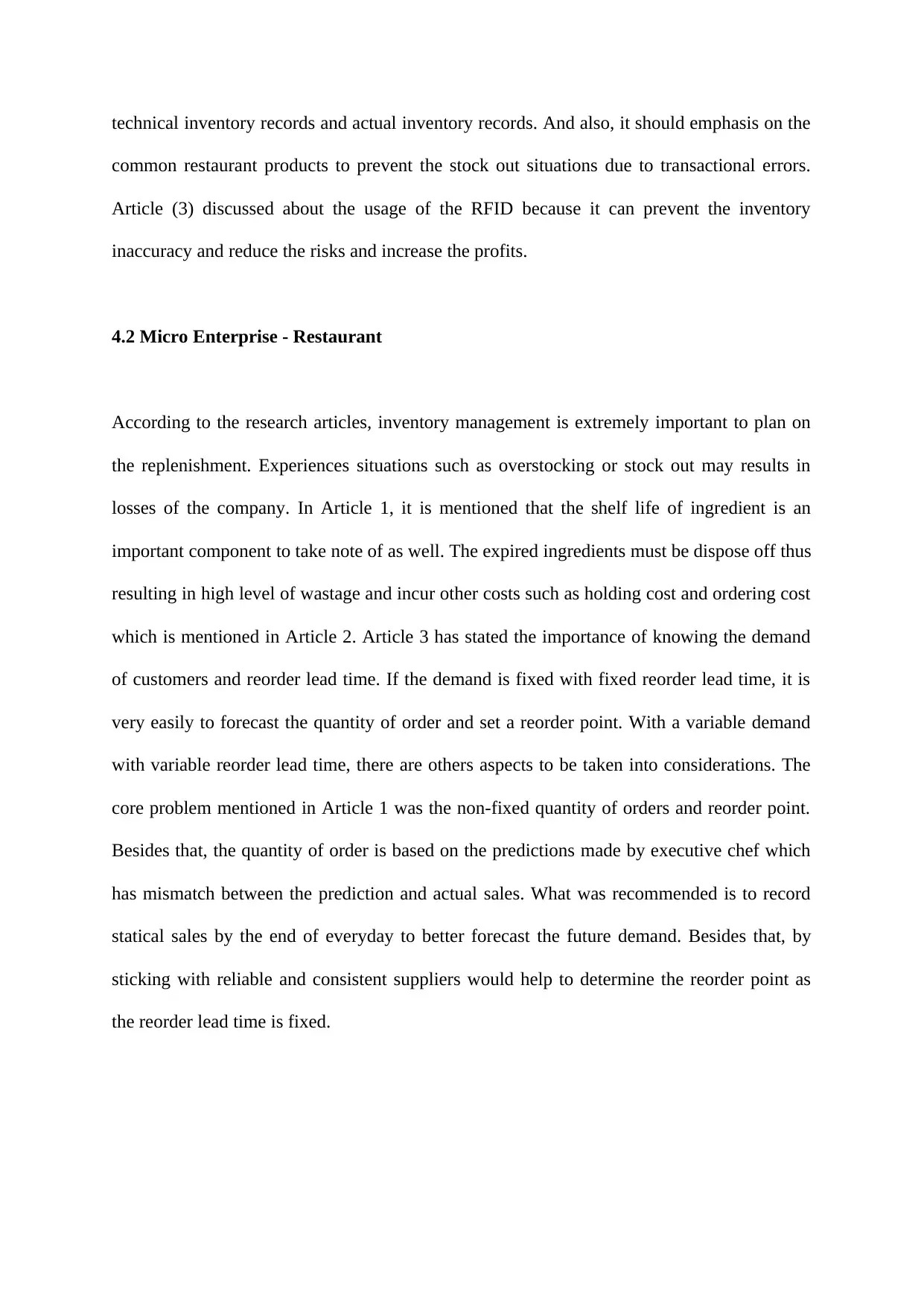
technical inventory records and actual inventory records. And also, it should emphasis on the
common restaurant products to prevent the stock out situations due to transactional errors.
Article (3) discussed about the usage of the RFID because it can prevent the inventory
inaccuracy and reduce the risks and increase the profits.
4.2 Micro Enterprise - Restaurant
According to the research articles, inventory management is extremely important to plan on
the replenishment. Experiences situations such as overstocking or stock out may results in
losses of the company. In Article 1, it is mentioned that the shelf life of ingredient is an
important component to take note of as well. The expired ingredients must be dispose off thus
resulting in high level of wastage and incur other costs such as holding cost and ordering cost
which is mentioned in Article 2. Article 3 has stated the importance of knowing the demand
of customers and reorder lead time. If the demand is fixed with fixed reorder lead time, it is
very easily to forecast the quantity of order and set a reorder point. With a variable demand
with variable reorder lead time, there are others aspects to be taken into considerations. The
core problem mentioned in Article 1 was the non-fixed quantity of orders and reorder point.
Besides that, the quantity of order is based on the predictions made by executive chef which
has mismatch between the prediction and actual sales. What was recommended is to record
statical sales by the end of everyday to better forecast the future demand. Besides that, by
sticking with reliable and consistent suppliers would help to determine the reorder point as
the reorder lead time is fixed.
common restaurant products to prevent the stock out situations due to transactional errors.
Article (3) discussed about the usage of the RFID because it can prevent the inventory
inaccuracy and reduce the risks and increase the profits.
4.2 Micro Enterprise - Restaurant
According to the research articles, inventory management is extremely important to plan on
the replenishment. Experiences situations such as overstocking or stock out may results in
losses of the company. In Article 1, it is mentioned that the shelf life of ingredient is an
important component to take note of as well. The expired ingredients must be dispose off thus
resulting in high level of wastage and incur other costs such as holding cost and ordering cost
which is mentioned in Article 2. Article 3 has stated the importance of knowing the demand
of customers and reorder lead time. If the demand is fixed with fixed reorder lead time, it is
very easily to forecast the quantity of order and set a reorder point. With a variable demand
with variable reorder lead time, there are others aspects to be taken into considerations. The
core problem mentioned in Article 1 was the non-fixed quantity of orders and reorder point.
Besides that, the quantity of order is based on the predictions made by executive chef which
has mismatch between the prediction and actual sales. What was recommended is to record
statical sales by the end of everyday to better forecast the future demand. Besides that, by
sticking with reliable and consistent suppliers would help to determine the reorder point as
the reorder lead time is fixed.
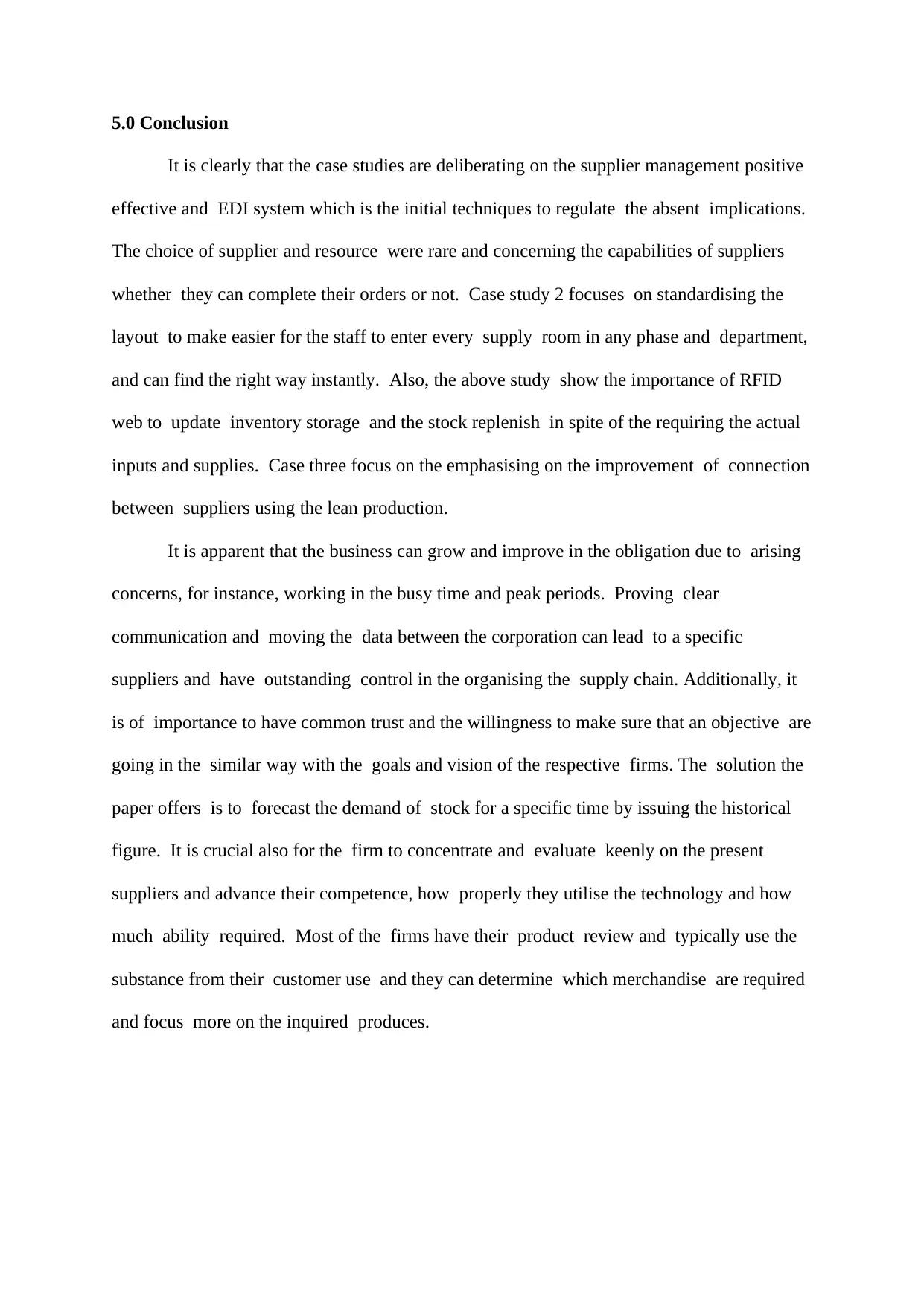
5.0 Conclusion
It is clearly that the case studies are deliberating on the supplier management positive
effective and EDI system which is the initial techniques to regulate the absent implications.
The choice of supplier and resource were rare and concerning the capabilities of suppliers
whether they can complete their orders or not. Case study 2 focuses on standardising the
layout to make easier for the staff to enter every supply room in any phase and department,
and can find the right way instantly. Also, the above study show the importance of RFID
web to update inventory storage and the stock replenish in spite of the requiring the actual
inputs and supplies. Case three focus on the emphasising on the improvement of connection
between suppliers using the lean production.
It is apparent that the business can grow and improve in the obligation due to arising
concerns, for instance, working in the busy time and peak periods. Proving clear
communication and moving the data between the corporation can lead to a specific
suppliers and have outstanding control in the organising the supply chain. Additionally, it
is of importance to have common trust and the willingness to make sure that an objective are
going in the similar way with the goals and vision of the respective firms. The solution the
paper offers is to forecast the demand of stock for a specific time by issuing the historical
figure. It is crucial also for the firm to concentrate and evaluate keenly on the present
suppliers and advance their competence, how properly they utilise the technology and how
much ability required. Most of the firms have their product review and typically use the
substance from their customer use and they can determine which merchandise are required
and focus more on the inquired produces.
It is clearly that the case studies are deliberating on the supplier management positive
effective and EDI system which is the initial techniques to regulate the absent implications.
The choice of supplier and resource were rare and concerning the capabilities of suppliers
whether they can complete their orders or not. Case study 2 focuses on standardising the
layout to make easier for the staff to enter every supply room in any phase and department,
and can find the right way instantly. Also, the above study show the importance of RFID
web to update inventory storage and the stock replenish in spite of the requiring the actual
inputs and supplies. Case three focus on the emphasising on the improvement of connection
between suppliers using the lean production.
It is apparent that the business can grow and improve in the obligation due to arising
concerns, for instance, working in the busy time and peak periods. Proving clear
communication and moving the data between the corporation can lead to a specific
suppliers and have outstanding control in the organising the supply chain. Additionally, it
is of importance to have common trust and the willingness to make sure that an objective are
going in the similar way with the goals and vision of the respective firms. The solution the
paper offers is to forecast the demand of stock for a specific time by issuing the historical
figure. It is crucial also for the firm to concentrate and evaluate keenly on the present
suppliers and advance their competence, how properly they utilise the technology and how
much ability required. Most of the firms have their product review and typically use the
substance from their customer use and they can determine which merchandise are required
and focus more on the inquired produces.
⊘ This is a preview!⊘
Do you want full access?
Subscribe today to unlock all pages.

Trusted by 1+ million students worldwide
1 out of 14
Related Documents
Your All-in-One AI-Powered Toolkit for Academic Success.
+13062052269
info@desklib.com
Available 24*7 on WhatsApp / Email
![[object Object]](/_next/static/media/star-bottom.7253800d.svg)
Unlock your academic potential
Copyright © 2020–2025 A2Z Services. All Rights Reserved. Developed and managed by ZUCOL.





